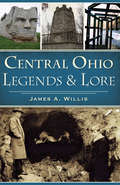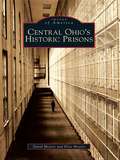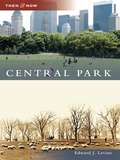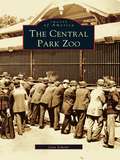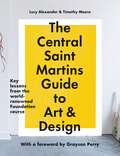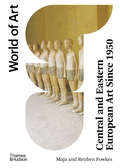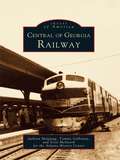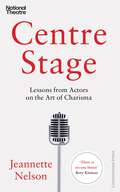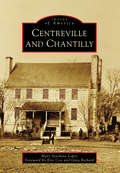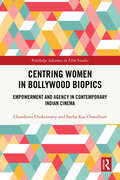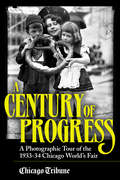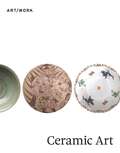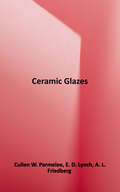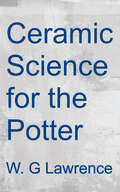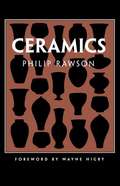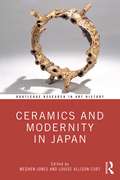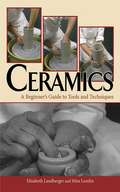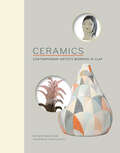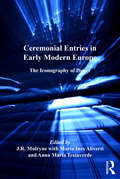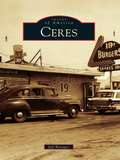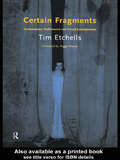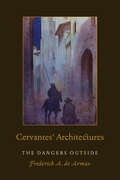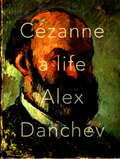- Table View
- List View
Central Ohio Legends & Lore
by James A. WillisThe legendary tales of Central Ohio reach far beyond the region. Bigfoot-like creatures have been sighted in the state since the 1800s. Wright-Patterson Air Force Base was the headquarters for the military’s investigations into UFO sightings in the mid-twentieth century. Some of Johnny Appleseed’s earliest orchards were planted near present-day Steubenville, Mansfield and Lima, and a farm in Nova boasts the last tree planted by Appleseed. Join James A. Willis as he travels across Central Ohio and delves into the Buckeye State’s stories of murderous villains, courageous heroes and even a few ghosts and monsters.
Central Ohio's Historic Prisons
by Elise Meyers David MeyersWith the opening of the Ohio State Reformatory in 1896, the state legislature had put in place "the most complete prison system, in theory, which exists in the United States." The reformatory joined the Ohio Penitentiary and the Boys Industrial School, also central-Ohio institutions, to form the first instance of "graded prisons; with the reform farm on one side of the new prison, for juvenile offenders, and the penitentiary on the other, for all the more hardened and incorrigible class." However, even as the concept was being replicated throughout the country, the staffs of the institutions were faced with the day-to-day struggle of actually making the system work.
Central Park
by Edward J. LevineHarper's Weekly reported in 1857 that no engineer had yet been able to present a feasible plan for Central Park and that "it may not ever happen." Their pessimism was misplaced, as Frederick Law Olmsted and Calvert Vaux's Greensward Plan was approved in May 1858. By 1860, visitors were enjoying the magnificent new park's naturalistic splendor. Central Park quickly became one of New York's premier attractions, featuring the menagerie, the mall, Bethesda Fountain, the Metropolitan Museum of Art, the music pavilion, the casino, and the original Croton Reservoir. The northern section of the park was more reminiscent of an untamed wilderness than of an urban park. Through historic postcards, Central Park highlights this man-made green oasis at the center of a teeming metropolis.
Central Park Zoo, The
by Joan ScheierCountless New Yorkers, as well as visitors from all parts of the world, have experienced an oasis just a few feet off Fifth Avenue in the heart of Manhattan. Since the 1860s, Central Park has been the home of three different zoos: the menagerie, the zoo of 1934, and what is today known as the Central Park Zoo. The Central Park Zoo begins with the menagerie of the 1860s, an impromptu public zoo begun when citizens and circuses started donating animals to the city. It continues in 1934, when Robert Moses-perhaps the most influential man in the city's planning history-built a newer zoo, remembered to this day for its lions, tigers, elephants, and gorillas. It ends with the brand new zoo and exhibits built in 1988 under the supervision of the Wildlife Conservation Society. With stunning, rarely seen images, The Central Park Zoo not only is a treat for the eyes but also comes alive with the barking of sea lions, the soft fur of snow monkeys, the sweet smell of peanut butter, and the taste of "ice cakes"-treats for the zoo residents, of course.
Central Saint Martins Foundation: Key lessons in art and design
by Lucy Alexander Timothy Meara Central Saint MartinsExplore and expand your creative skill set with The Central Saint Martins Guide to Art & Design, fully updated in 2023 in line with the current course, with a new afterword by Rathna Ramanathan, Head of Central Saint Martins.Guided by key lessons from college tutors, you'll learn to expand your creative abilities and develop your own visual language. Exclusive projects from the world-class Central Saint Martins Foundation Diploma in Art and Design will inspire your experiments and unlock your potential across four key areas: communication design, fashion and textiles, fine art and three-dimensional design. No matter which discipline you choose to pursue, this book will help you discover who you want to be and set you on the path to achieving it.'Do you care about heartbreaking beauty, fresh new ideas, astounding craftsmanship, ingenious solutions, the tingle of a shocking image? Would you make art even if it wasn't your job? Then this is the book for you' - Grayson Perry
Central Saint Martins Foundation: Key lessons in art and design
by Lucy Alexander Timothy Meara Central Saint MartinsExplore and expand your creative skill set with The Central Saint Martins Guide to Art & Design, fully updated in 2023 in line with the current course, with a new afterword by Rathna Ramanathan, Head of Central Saint Martins.Guided by key lessons from college tutors, you'll learn to expand your creative abilities and develop your own visual language. Exclusive projects from the world-class Central Saint Martins Foundation Diploma in Art and Design will inspire your experiments and unlock your potential across four key areas: communication design, fashion and textiles, fine art and three-dimensional design. No matter which discipline you choose to pursue, this book will help you discover who you want to be and set you on the path to achieving it.'Do you care about heartbreaking beauty, fresh new ideas, astounding craftsmanship, ingenious solutions, the tingle of a shocking image? Would you make art even if it wasn't your job? Then this is the book for you' - Grayson Perry
Central and Eastern European Art Since 1950 (World of Art #0)
by Maja Fowkes Reuben FowkesA groundbreaking introduction to the contemporary art of central and Eastern Europe, this wide-ranging study explores painting, sculpture, photography, performance, and conceptual work. In this pathbreaking new history, Maja and Reuben Fowkes introduce outstanding artworks and major figures from across central and Eastern Europe to reveal the movements, theories, and styles that have shaped artistic practice since 1950. They emphasize the particularly rich and varied art scenes of Poland, Czechoslovakia, Hungary, and Yugoslavia, extending their gaze at intervals to East Germany, Romania, the Baltic states, and the rest of the Balkans. This generously illustrated overview explores the richness of this region’s artists’ singular contribution to recent art history. Tracing art-historical changes from 1950 to now, the authors examine the repercussions of political events on artistic life—notably the uprisings in Hungary and Czechoslovakia, the Solidarity movement in Poland, and the collapse of the communist bloc. But their primary interest is in the experimental art of the neo-avant-garde that resisted official agendas and engaged with global currents such as performance art, video, multimedia, and net art. Central and Eastern European Art Since 1950 is a comprehensive, transnational survey of the major movements of art from this region.
Central of Georgia Railway
by Atlanta History Center Scott Mcintosh Tammy Galloway Jackson McquiggOrganized in 1833 by Savannah businessmen, the Central of Georgia Railway was chartered by the Georgia Legislature as the Central Rail Road & Canal Company. The line, connecting Savannah to the interior of the state, boosted the coastal city's seaport, which had lost business to Charleston because of the South Carolina Rail Road's inland reach. In 1843, the Central was extended from Savannah to the outskirts of Macon, and after nearly 120 years of successful operation, the Central of Georgia Railway was purchased by Southern Railway. By 1982, it became merely an accounting entry in the books of Norfolk Southern, a major transportation company.
Centre Stage: Lessons from Actors on the Art of Charisma
by Jeannette NelsonHow the world’s best actors communicate with gravitas – and how you can, too.‘The theatre stars’ voice guru’ Daily MailActing is all about charisma. Whether you’re an A-list star or an extra, when you’re on stage you need to perform in a way that makes your audience listen.That stage presence is something we can all learn from. Every time you speak up in a meeting, recount an anecdote, or tell a joke, it’s essential to communicate with gravitas.Jeannette Nelson knows a thing or two about gravitas. As Head of Voice at the National Theatre, she has spent three decades working with the world’s leading actors – from Al Pacino to Benedict Cumberbatch to Juliette Binoche – teaching them to speak clearly and move confidently.Now, Nelson pulls back the curtain on the tricks that professional performers use to own the room. Starting with clear speech and good posture, before moving on to the art of rhetoric and overcoming stage fright, she outlines a holistic three-stage method to communicating with authority, authenticity and eloquence. Throughout, she peppers the book with stories of how world-renowned actors learnt to make themselves heard – and how you can, too.The result is a fascinating and eminently practical guide to the art of performance. If all the world’s a stage, then this book will turn you into its lead actor.
Centreville and Chantilly
by Eric Cox Gina Richard Mary Stachyra LopezCentreville and Chantilly are located 25 miles west of Washington, DC, and both share rich Civil War histories. Centreville overcame occupation by two armies during the Civil War. Four Chimney House, the home of a prominent Centreville businessman, first became the headquarters of Union general Irvin McDowell, then the headquarters of Confederate general Joseph E. Johnston. Johnston also used the Mount Gilead home, which is still standing, as his personal residence. In Chantilly, after the Second Battle of Bull Run, Confederate forces led by Stonewall Jackson clashed with Union troops at the Battle of Chantilly (also known as Ox Hill), where Union generals Philip Kearny and Isaac Stevens met their deaths. Centreville and Chantilly shares with readers the stories and photographs of two communities that greatly respect their past and embrace their change. Today, Centreville's agricultural heritage lives on alongside modern-day entrepreneurialism at Cox Farms, while Chantilly is home to the National Air and Space Museum's Udvar-Hazy Center and Dulles International Airport.
Centring Women in Bollywood Biopics: Empowerment and Agency in Contemporary Indian Cinema (Routledge Advances in Film Studies)
by Chandrava Chakravarty Sneha Kar ChaudhuriThis book explores the dramatic rise in popularity of the women’s biopic in contemporary Bollywood, within the context of wider cultural shifts over the past decade.Delving into the societal shifts reflected in the genre, both on and off screen, the book explores the contours of individual agency and the centring of women in Indian cinema. The book offers new insight into women-centric Hindi biopics, a fast-rising genre carving out a tradition of its own, with female directors and actors contributing to this rising postfeminist celebration of women’s agency and individuality. The authors posit that the alternative narratives, created by Bollywood and accepted by mainstream audiences, have become a catalyst to elevate women or female actors to protagonists, without the need to conform to the sexist mores of mainstream Bollywood.This book will be of interest to scholars, researchers and upper-level students in the areas of film studies, media industries, gender and feminism, and South Asian studies.
Century of Progress: A Photographic Tour of the 1933–34 Chicago World's Fair
by Chicago Tribune StaffBetween 1933 and 1934, over 48 million visitors attended "A Century of Progress Exposition," the world's fair located in Chicago, Illinois. Conceived of during the Roaring Twenties and born during the Great Depression, this was a sprawling event celebrating Chicago's 100th anniversary with industrial and scientific displays, lascivious entertainment, and a touch of unadulterated bad taste.Century of Progress is a collection of rare photographs from the world's fair that has been carefully chosen from the Chicago Tribune's voluminous archives. Featuring an informative introduction by Tribune reporter and historian Ron Grossman, this book documents one of the most expansive displays of technological advancement and cultural diversity that took place in the 20th century. The lakefront exposition, on the present site of McCormick Place and Northerly Island, opened on May 27, 1933, and was reopened in 1934 at the urging of President Franklin D. Roosevelt who hoped it would stimulate the Depression-era economy.This book is an engrossing and fascinating look at the numerous sides of the "A Century of Progress Exposition": the whimsical attractions, the architectural and scientific achievements, the palpable spirit of fun, and the occasionally unsavory exhibits of differing cultures. At a time when the entire U.S. population numbered just over 125 million people, the Chicago world's fair left an indelible mark on the collective consciousness of American culture, and Century of Progress captures that feeling as only a photograph can.
Ceramic Art (ART/WORK)
by Margaret S. Graves Sequoia Miller Magdalene Odundo Vicki ParryA new examination of the history of ceramic art, spanning ancient to modern times, emphasizing its traditions, materials, and methods of makingConcise but comprehensive, Ceramic Art brings together the voices of art historians, conservators, and artists to tell the history of making art from fired clay. The story spans history and continents, examining the global traditions of ceramists that range from pre-Columbian Peruvian artisans to contemporary African studio potters.The volume shows how human need gave rise to multiple traditions in earthenware, stoneware, porcelain, glaze, and surface decoration from Africa, Asia, Europe, the Middle East, and the Americas. Essays describe the core materials and practice of ceramics, followed by consideration of its production, consumption, and use. Throughout, the focus is on the power of materials and the role conservation plays in the afterlife of a ceramic object.An accessible introduction to an ancient practice, Ceramic Art offers new ways of thinking about the broader forces that have shaped the traditions of the medium.
Ceramic Glazes
by Cullen W. ParmeleeThe preparation of this book on the subject of ceramic glazes was the result of many years of research on glazes, teaching the subject to ceramists and constant and close observation of work recorded throughout the world. Although literature on glazes is widespread, at no time has it been assembled into one single volume so completely as here. It is presented in such a way that both student and professional will benefit by the revealing contents. Professor Parmelee was a deep student of the subject and recognized as the foremost authority on glazes.
Ceramic Painting
by Diana FisherCeramic painting is an ancient art form that derived from the desire to beautify the simple tools of hearth and home. It has now reached a state of expression that ranges from museum art to interior design. In this book, the author shows you how to create your own beautiful and lasting designs with easy-to-follow, step-by-step instructions. Through simple and more involved techniques, you will be able to explore the many facets of ceramic painting with confidence, even if you have no artistic training.
Ceramic Science For The Potter (Creative Crafts Ser.)
by W. G. LawrenceThe ceramic artist, potter or designer makes use of materials to create a useful and appealing object. In this creative effort he uses many types of materials, often with little background knowledge as to how they may be¬have. Unexpected or disappointing results may ultimately be corrected on a trial and error basis but usually at too great a cost in time and jangled nerves. For those who have made such mistakes and who wish to understand their materials more thoroughly, this book will be useful.
Ceramics
by Philip Rawson Wayne Higby"It is rare to find a book on art that presents complex aesthetic principles in clear readable form. Ceramics, by Philip Rawson, is such a book. I discovered it ten years ago, and today my well-worn copy has scarcely a page on which some statement is not underlined and starred."--Wayne Higby, from the Foreword
Ceramics and Modernity in Japan (Routledge Research in Art History)
by Meghen M. Jones Louise Allison CortCeramics and Modernity in Japan offers a set of critical perspectives on the creation, patronage, circulation, and preservation of ceramics during Japan’s most dramatic period of modernization, the 1860s to 1960s. As in other parts of the world, ceramics in modern Japan developed along the three ontological trajectories of art, craft, and design. Yet, it is widely believed that no other modern nation was engaged with ceramics as much as Japan—a "potter’s paradise"—in terms of creation, exhibition, and discourse. This book explores how Japanese ceramics came to achieve such a status and why they were such significant forms of cultural production. Its medium-specific focus encourages examination of issues regarding materials and practices unique to ceramics, including their distinct role throughout Japanese cultural history. Going beyond descriptive historical treatments of ceramics as the products of individuals or particular styles, the closely intertwined chapters also probe the relationship between ceramics and modernity, including the ways in which ceramics in Japan were related to their counterparts in Asia and Europe. Featuring contributions by leading international specialists, this book will be useful to students and scholars of art history, design, and Japanese studies.
Ceramics: A Beginner's Guide to Tools and Techniques
by Mita Lundin Elisabeth LandbergerThis comprehensive guide covers the materials, tools, methods, and techniques for making original ceramic pieces in a wide range of forms. From hand sculpting to pinching, wheel throwing to slip casting, here you'll ?nd easy-to-follow instructions accompanied by beautiful photographs to make the world of ceramics clear and exciting. Readers will also learn about glazes, ?ring techniques, decorating tips, and much more.
Ceramics: Contemporary Artists Working in Clay
by Kate SingletonThis ebook presents the work of 30 contemporary artists who have turned to clay to shape their most innovative ideas into stunning works of art. From cups shaped like crystals to a tree trunk made of porcelain and stoneware planters painted to look like ladies, popular curator and blogger Kate Singleton collects here whimsical pieces with narrative, graphic, curious, and organic qualities that blur the line between fine art, design, and craft. Ceramics is a vital guide to an evolving medium and for those interested in the future of art and craft.
Ceremonial Entries in Early Modern Europe: The Iconography of Power (European Festival Studies: 1450-1700)
by J. R. Mulryne Maria Ines Aliverti Anna Maria TestaverdeThe fourteen essays that comprise this volume concentrate on festival iconography, the visual and written languages, including ephemeral and permanent structures, costume, dramatic performance, inscriptions and published festival books that ’voiced’ the social, political and cultural messages incorporated in processional entries in the countries of early modern Europe. The volume also includes a transcript of the newly-discovered Register of Lionardo di Zanobi Bartholini, a Florentine merchant, which sets out in detail the expenses for each worker for the possesso (or Entry) of Pope Leo X to Rome in April 1513.
Ceres
by Jeff BenzigerFertile soil drew Ceres founder Daniel Whitmore to the flat land south of the Tuolumne River in California's San Joaquin Valley in 1867. Named for the Roman goddess of agriculture, Ceres was laid out in 1875 among the stalks of grain. A devout Baptist, Whitmore offered free lots to anyone who wanted to make Ceres their home with a pledge never to use alcohol. As irrigation water and railroad tracks were later introduced, the town flourished as an agricultural community where peaches, almonds, and walnuts are grown. Today Ceres has retained its agricultural roots, and drinking is now permissible. In fact, one of the nation's largest wine producers, Bronco Winery, calls Ceres home. Residents come together as a community with the Ceres Street Faire, summer Concerts in the Park, Farmers Market and the dazzling Christmas Tree Lane.
Certain Fragments: Texts and Writings on Performance
by Tim EtchellsWhat is the relationship between performance and play? Between performance and technology? Between performance and death? Certain Fragments is an extraordinary exploration of what lies at the heart of contemporary theatre. Written by the artistic director of Forced Entertainment, acknowledged to be Britains most brilliant experimental theatre company (Guardian), Certain Fragments investigates the processes of devising performance, the role of writing in an interdisciplinary theatre, and the influence of the city on contemporary art practice. Tim Etchells unique and provocative voice shifts from intimate anecdote to critical analysis and back again. And as in his theatre-making so in his book: with Certain Fragments Etchells disrupts traditional notions of creative, academic, and intellectual work. The book is an exciting and radical fusion of story-telling and criticism. It also makes available, for the first time, four seminal Forced Entertainment texts by Etchells.
Cervantes’ Architectures: The Dangers Outside (Toronto Iberic)
by Frederick A. de ArmasCervantes’ Architectures is the first book dedicated to architecture in Cervantes’ prose fiction. At a time when a pandemic is sweeping the world, this book reflects on the danger outside by concentrating on the role of enclosed structures as places where humans may feel safe, or as sites of beauty and harmony that provide solace. At the same time, a number of the architectures in Cervantes trigger dread and claustrophobia as they display a kind of shapelessness and a haunting aura that blends with the narrative. This volume invites readers to discover hundreds of edifices that Cervantes built with the pen. Their variety is astounding. The narrators and characters in these novels tell of castles, fortifications, inns, mills, prisons, palaces, towers, and villas which appear in their routes or in their conversations, and which welcome them, amaze them, or entrap them. Cervantes may describe actual buildings such as the Pantheon in Rome, or he may imagine structures that metamorphose before our eyes, as we come to view one architecture within another, and within another, creating an abyss of space. They deeply affect the characters as they feel enclosed, liberated, or suspended or as they look upon such structures with dread, relief, or admiration. Cervantes' Architectures sheds light on how places and spaces are perceived through words and how impossible structures find support, paradoxically, in the literary architecture of the work.
Cezanne
by Alex DanchevAlex Danchev gives us the first comprehensive assessment of the revolutionary work and restless life of Paul Cézanne to be published in decades. One of the most influential painters of his time and beyond, Cézanne was the exemplary artist-creator of the modern age who changed the way we see the world. With brisk intellect, rich documentation, and eighty-eight color and fifty-two black-and-white illustrations, Danchev tells the story of an artist who was originally considered a madman, a barbarian, and a sociopath. Beginning with the unsettled teenager in Aix, Danchev takes us through the trials of a painter who believed that art must be an expression of temperament but was tormented by self-doubt, who was rejected by the Salon for forty years, who sold nothing outside his immediate circle until his thirties, who had a family that he kept secret from his father until his forties, who had his first exhibition at the age of fifty-six--but who fiercely maintained his revolutionary beliefs. Danchev shows us how the beliefs Cézanne held and the life he led became the obsession and inspiration of artists, writers, poets, and philosophers from Henri Matisse and Pablo Picasso to Samuel Beckett and Allen Ginsberg. A special feature of the book is a remarkable series of Cézanne's self-portraits, reproduced in full color. Cézanne is not only the fascinating life of a visionary artist and extraordinary human being but also a searching assessment of his ongoing influence in the artistic imagination of our time. A stunning portrait of a monumentally important artist, this is a biography not to be missed.
